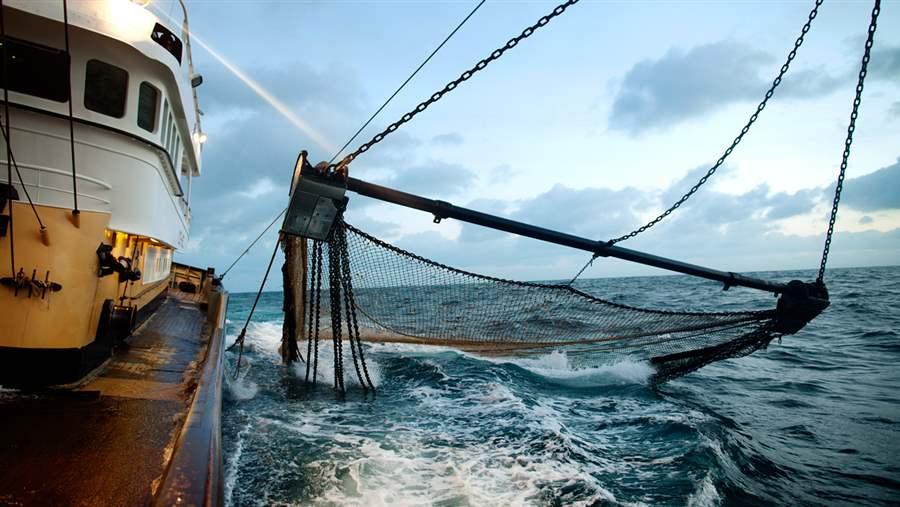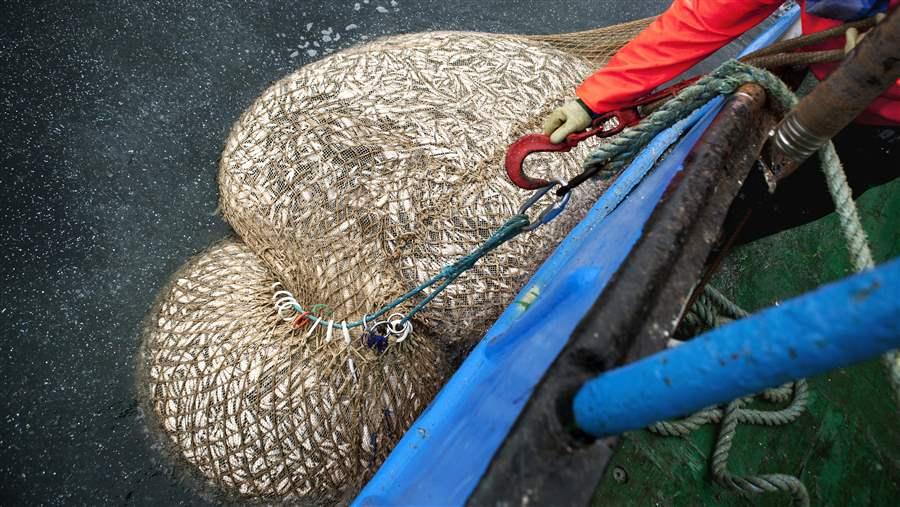EU Needs Swift Progress to End Overfishing by 2020 Deadline
Report shows many stocks still not being fished at sustainable levels
Overview
In 2013, decision makers in the European Union agreed to far-reaching reforms to their Common Fisheries Policy (CFP) and set overarching goals for restoring fish stocks in EU waters. The new CFP included a legally binding commitment to end overfishing by 2015 where possible, and by 2020 at the latest, so that stock biomass—the total weight of a fish population—can be restored and maintained above sustainable levels.
Taking Stock, a new report1 commissioned by The Pew Charitable Trusts and conducted by fisheries consultancy Poseidon Aquatic Resource Management Ltd., assesses progress toward these goals since the CFP took effect at the start of 2014, and concludes that the EU and its member states need to accelerate efforts to end overfishing in order to meet the looming 2020 deadline. Doing so would allow fish stocks to recover and increase the long- term social and economic benefits from EU fisheries.
Overfishing should be a thing of the past
In the decades leading up to the CFP reform, overfishing had left many fish stocks in EU waters exploited unsustainably and, in some cases, vulnerable to collapse. The fishing industry often suffered from lower yields and lower profits than would have been possible with more effective fisheries management. This is not a problem unique to Europe: In 2017, the World Bank estimated that better management of global fisheries would unlock $83 billion in additional revenue worldwide.2 That study reiterated other research indicating that sustainable fisheries are good not just for the marine environment but for the bottom lines of fishing businesses and coastal communities as well.
Given the CFP deadline to end overfishing in Europe where possible by 2015, the task should be all but completed.
Given the CFP deadline to end overfishing in Europe where possible by 2015, the task should be all but completed—with only the most difficult cases remaining on a progressive and incremental path to sustainable fishing levels.3 Instead, official data released annually by the EU Commission consistently show an alarming proportion of fishing limits still being set too high, and too many stocks yet to recover.4
Report assesses progress made by the EU to end overfishing and rebuild fish stocks
The Poseidon report analyses the data on fishing limits and biomass over five years, starting in 2013, as the CFP reforms were being finalised and then implemented. The research assesses how successfully the EU has put the reforms in place and whether decision makers are on course to meet the CFP deadlines.
The critical questions asked were:
To what extent is scientific advice being followed in setting fishing limits?
To what extent are fish stocks at the biomass levels required by the CFP?
The EU Commission, the executive arm of the EU, reports on some of these trends but so far has not put all of the information in one place. Important elements are often omitted as well, such as assessments of the extent to which decisions made by the Council of the EU, made up of fisheries ministers from each of the 28 member states, match scientific advice, or the state of stock biomass compared to the CFP’s maximum sustainable yield (MSY) measure of biomass. MSY refers to the largest average yield, or catch, that can theoretically be taken from a stock without having an impact on the long-term stability of the population.
Methodology
The Poseidon researchers used multiple data sources, looking at stocks in the Baltic Sea, the North Sea and the EU’s western waters. They compared official scientific advice on fishing limits for each stock with the limits actually set by fisheries ministers in their Council meetings each year.
Analysts examined the official data on stock biomass for each year against several benchmarks of the biomass levels that can produce the maximum sustainable yield (MSY), the objective of the CFP. Looking at the data on these parameters over five years, the researchers draw conclusions about how much progress has been made, and how much remains to be made by 2020.
Key findings
The trends identified in the report demonstrate some improvements in terms of reducing the levels of overfishing, changes consistent with official EU data. However, the report also notes that significant levels of overfishing persist because decision makers continue to set fishing limits too high, and it indicates that current developments do not put the EU on track to end overfishing by the 2020 deadline—unless significant changes are made in the next three years.
The conclusions on the growth of stock biomass paint a similar picture. Stock biomass is generally increasing, but recovery is nowhere near fast enough. Few stocks have been clearly identified as having recovered above the biomass level that can achieve MSY. Meanwhile, the broader picture is clouded by a lack of data or clear benchmarks for this key CFP aim.
Pew analysis of data: Insufficient progress toward ending overfishing
The report found that the Council of the EU set 55 percent of fishing limits higher than scientific advice for 2017, down slightly from 58 percent in 2014. The overall trend since 2013 in these percentages broadly matches the findings of the Commission’s official reporting, which uses a smaller data set.5 The trend is clear: Each year, fisheries ministers meeting in Council still set more than half of limits too high. That makes meeting the 2020 deadline more difficult with each passing year.
With such slow improvement, the CFP goal could soon be out of reach
If ministers continue to set limits above scientific advice, at current rates as many as half of stocks could still be overfished in 2020, contravening EU law. Alternatively, ministers could decide to make a last-minute and, by necessity, large-scale shift to following the scientific advice for all stocks as the deadline approaches. To avoid that type of disruptive approach, ministers should take the progressive, incremental steps needed now, so they can meet the 2020 deadline that they committed to as part of the CFP reform.
Stock recovery a long way from meeting CFP aims
Official sources include assessments of stock biomass in their reports but provide little data on how well stocks are faring against the CFP objective to bring them above the biomass levels capable of producing maximum sustainable yield. Less than 10 percent of EU fish stocks examined in the report have official scientific estimates of the levels of biomass relative to CFP objectives. In the absence of such public information, researchers looked at other benchmarks, known as reference points, that EU fisheries managers use to evaluate progress against CFP objectives—and which in most cases are less ambitious than the MSY benchmark.
Reference points generally define the limits, targets or boundaries of fishing levels or biomass that are consistent with particular management objectives. Regardless of how MSY is measured, whether using lower, middle or higher estimates, the numbers show some progress in increasing stock biomass. Still, a significant proportion of stocks (24 to 56 percent, depending on the benchmark) have not yet been rebuilt above levels capable of producing MSY.
Limited Transparency Hinders Efforts to Measure Progress
Major omissions in the EU fisheries data made publicly available by the European Commission—and the lack of transparency in the Commission and Council process that sets fishing limits—make it difficult to draw conclusions on the progress made to implement the CFP.
For example, in many instances, the researchers could not simply compare scientific advice against the fishing limits because of mismatches between the parameters or data sets used by the Council to make decisions and the Commission to report on progress.
Communications from the Commission and member state governments often present a variety of different measures of progress, for example presenting stocks as being “in line with” MSY, or describing them as “sustainably managed”6—without specifics on the measures used or a clear picture of stock recovery against the MSY objective. More clearly presented official data on progress toward implementing the CFP would help everyone understand decisions—and better hold decision makers to account.
More clearly presented official data on progress toward implementing the CFP would help everyone understand decisions—and better hold decision makers to account.
A way forward
EU decision makers have limited time to meet the objectives set in the CFP by 2020. Doing so will require cooperation and constructive efforts from all key players. Based on the report’s findings, Pew recommends several essential steps:
- Fisheries ministers must consistently set science-based catch limits in order to make much faster progress in the effort to end overfishing by the CFP deadline. Decisions taken by the Council of the EU over the
- next three years will determine how quickly Europe will achieve the environmental, social and economic benefits that come from sustainably managed fisheries.
- Because ministers too often have not followed through on the clear commitments to meet the deadlines in EU law, the EU Commission and members of the European Parliament can play crucial roles in holding ministers to account.
- The transparency of decision making on EU fisheries management should be greatly improved, for the benefit of the fishing industry and the public. Official reporting on progress toward CFP goals should provide a clear, consistent picture of the extent to which fishing mortality meets the law’s requirements as well as of the number of stocks that have not yet recovered above the required biomass levels. The public cannot understand progress or hold decision makers accountable if the information used to justify policies remains secret.
- New tools in the CFP that focus on long-term fishery sustainability must be used to achieve the policy’s ultimate objectives. For example, well-crafted multi-annual plans (MAPs) for fish stocks are essential, although some previous proposals have already been watered down. The EU needs MAPs that deliver the CFP objectives by keeping fishing within the MSY limit for all stocks.
Conclusion
The Taking Stock report paints a mixed picture of progress toward delivering the CFP’s objectives. Fisheries ministers are still setting too many fishing limits above the scientific advice, which is likely to hamper the rebuilding of stocks to the required levels. To make matters worse, insufficient data are made publicly available on the state of stocks measured against the CFP benchmark.
Clearly, much progress remains to be made. EU decision makers need to make significant and rapid improvements when setting fishing limits if the CFP’s ambition of ending overfishing by 2020 is to be achieved.
Endnotes
- Poseidon Aquatic Resources Management Ltd., “Taking Stock: Progress Towards Ending Overfishing in the European Union” (2017), http://www.consult-poseidon.com/fishery-reports/Poseidon_Taking_Stock_2017.pdf.
- The World Bank, “The Sunken Billions Revisited: Progress and Challenges in Global Marine Fisheries” (2017), https://openknowledge.worldbank.org/bitstream/handle/10986/24056/9781464809194.pdf.
- European Union, “Regulation (EU) No 1380/2013 of the European Parliament and of the Council of 11 December 2013 on the Common Fisheries Policy, Amending Council Regulations (EC) No 1954/2003 and (EC) No 1224/2009 and Repealing Council Regulations (EC) No 2371/2002 and (EC) No 639/2004 and Council Decision 2004/585/EC,” Official Journal of the European Union (2017), http://eur-lex.europa.eu/legal-content/EN/TXT/PDF/?uri=CELEX:32013R1380&qid=1502977777888&from=EN.
- Scientific, Technical and Economic Committee for Fisheries (STECF), “Monitoring the Performance of the Common Fisheries Policy (STECF-17-04)” (2017), https://stecf.jrc.ec.europa.eu/documents/43805/55543/STECF+17-04+-+Monitoring+the+CFP.pdf.
- Ibid.
- European Commission, “Communication From the Commission on the State of Play of the Common Fisheries Policy and Consultation on the Fishing Opportunities for 2018” (2017), http://eur-lex.europa.eu/legal-content/EN/TXT/ PDF/?uri=CELEX:52017DC0368&from=EN.












